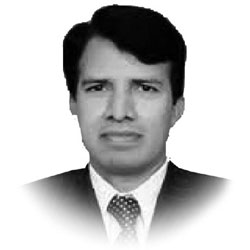Rising trends of secularism in the Middle East
WITH the rise of multiple power centres at global level, the international power politics is undergoing a rapid change.
The changing paradigms of international power politics have greatly impacted the regional politics of various regions across the globe, especially the geographic regions of Asia and Africa.
Indeed, Asia and Africa are the major focus of international power politics where major powers are competing for their respective influences at three levels; political, economic and strategic.
Almost all regions of Asia and Africa felt the heat of major power’s power-politics. Nevertheless, the Middle East and North Africa, also known as the MENA region is drastically affected owing to clashing interests of major powers in the region.
Politically named as the Middle East, this region has Muslim identity with Islam as defining factor in the life of its over 456 million population.
The Middle Eastern region extends from Iran in the East and Tunisia and Morocco in the West.
All Middle Eastern states are predominantly Muslim except Jewish State of Israel, established in 1948 by US and France, then colonial powers.
The Middle East has maintained its Islamic identity ever since the advent of Islam in early 7th Century.
Despite dozens of wars, the spread of Islam in Arab and elsewhere in the world remained non-violent with the positive theme of mutual and peaceful coexistence.
The establishment of the Madinah State and its constitutional provisions offered an unparalleled model of interfaith harmony and mutual coexistence among the believers of all divine religions.
The Middle Eastern region has undergone many evolutionary and revolutionary changes in its over 1400 year’s history.
Nevertheless, the region maintained a balanced Islamic approach without any radical leaning.
Like the rest of the world, the Post-9/11global events severely impacted the Middle Eastern region and it was delineated as the core of militancy.
The architect of this international school of thought labelled Islam as the ideology behind this so-called radical mind-set which led towards widespread militancy and terrorism.
Whereas the ground realities are quite different since Islam does not promote militancy nor can Muslims be declared as militants.
Subsequent to this critical international event the international players started targeting the Middle Eastern region and adjoining states Afghanistan through a well-planned military strategy of waging a long-war; the global war on terror.
The Western scholars provided an academic coverage to this format of warfare under liberal interventionist approach and the United Nations had to grant consent under the pressure of permanent members of UN Security Council.
The initial targets of the global war on terror were Afghanistan and Iraq.Indeed, the first phase of this war was aimed to overthrow the regimes which were unwilling to accept all-out supremacy of West and global hegemony of the United States.
Indeed, Al-Qaeda and later Daesh (Islamic State or Islamic State of Iraq and Levant-ISIS) were created on the bases (pretexts) to conduct the large-scale military operations in the entire Middle East and North Africa.
Both these militant groups had the Islamic identity and their militancy was labelled as the Islamic militancy with Muslim as militants.
In a way, the entire militancy and terrorism was linked to Muslims and Islam. One by one Muslim states of Middle East were targeted through: militarily interventions, regime change, creating intra-state and inter-state conflicts and through activation of Al-Qaeda and Daesh (ISIS).
The crux of this war on terror was to target Islam by projecting it as the motivating factor behind radicalization, militancy and terrorism at the global level.
From 2010-2015 the entire Middle Eastern region was thrust into a revolt and defiant status under garb of so-called Arab Spring with an overt agenda of democratization and human rights.
Nevertheless, the covert agenda was the selected regime change and threatened those ruling elites who might have thought of defying the western ordains.
The Arab Spring neither brought democracy in the Middle East nor it elevated the rights of those who struggled during the so-called movement against ruling elites.
Rather, the uprisings further pushed the region into chaos, civil war, militancy and uncertain future while creating a wide gulf between ruling elites and struggling streets.
The covert motives of the planners of this entire drive were to create a wide-ranging anarchism in the region where there are clashes among the masses at three levels: sectarian, ethnic and tribal, while creating distrust between rulers and the masses.
This all is evident in the contemporary Middle East with inter-state and intra-state conflicts as the order of the day.
Countries like Iraq, Syria, Libya, Yemen, Palestinian areas and Lebanon are evidently regions of conflict, based on abovementioned factors.
The ultimate goal of the planners is to reveal to the international community that, all conflicts and clashes have their origin in the predominant Muslim world and Islam is the inspiring spirit behind radicalization and militancy.
By blaming Islam as the motivating factor behind all forms of militancy and terrorism, the planners of this abhorrent game intend to introduce the secularism as the way forward for Muslim world in order to be acceptable for the rest of world.
Since the Middle Eastern region constitutes the core of Muslim world with Holy Kaabain Makkah and Prophet’s Mosque (Masjid-e-Nabwi) in Madinah, the strategic planners of this terrible anti-Islam campaign intends starting their campaign from this region.
Since the Muslim world takes the lead from land of Hejaz, therefore, Secularism of Middle Eastern region would pave the way for secularization of Muslim states world-wide and recognition of the State of Israel, despite its illegal occupation of Palestinian’s land.
Introduction of Secularism with un-Islamic values and norms pose a great threat to Islamic identity of the Muslim world, especially the Middle East.
The next phase would embrace the re-education of Muslims in line with the western secular values, away from the spirit of Islam.
— The writer is Professor of Politics and IR at International Islamic University, Islamabad.










